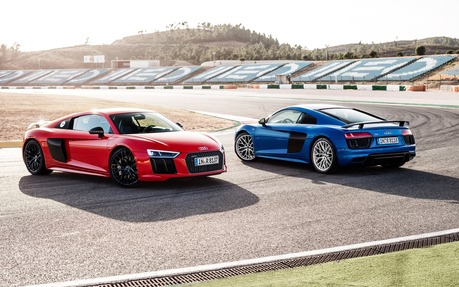2017 Audi R8 V10 Plus: A Second Generation With Genuine Upgrades
You need only string together a few laps around a circuit like the Autodromo Internacional do Algarve, near Faro, Portugal, to realize that the new Audi R8 V10 Plus has developed into a serious rival for the established exoticars.
Muscle
Its naturally aspirated 5.2-litre V10 now produces 602 horsepower, matching the power output of the Lamborghini Huracán. It generates intoxicating music as it screams to its 8,700-rpm redline.
- Also: Audi R8 LM: A Canadian Exclusive
- Also: Here Is The Audi That Will Race At The 24 Hours Of Le Mans
The second-generation R8 is lighter but more rigid thanks to its hybrid aluminum-carbon-fibre frame, but more importantly, it is more satisfying to drive, achieving lateral acceleration in excess of 1G when cornering. The screen in the Audi’s Virtual Cockpit spells it out for you quite clearly in Track mode.
Maximum torque is available at 6,500 rpm, and maximum power at 8,250. Engine response to throttle inputs is instantaneous. The sounds produced are just as exciting whether you are accelerating hard or slowing for a corner.
On track
As expected, the brakes with their carbon-ceramic rotors are outstanding: deceleration is instant, but easily modulated. There is a hint of understeer on turn-in, but trail braking on entry sets the car up for the apex, where it’s back on the gas for a bat-out-of-hell corner exit.
In a word, the R8 V10 Plus is thrilling to drive on a track like the one in Portimão, and the driving experience is on par with the exotics. This R8 was developed in conjunction with the R8 LMS endurance racer bred for events like the 24 Hours of Le Mans.
Points in common with its built-for-Le Mans cousin
These cars share 50% of their components, which helps to explain why the R8 V10 Plus is so at home on the track. The 5.2-litre V10 in the R8 V10 Plus actually develops more power than the engine in the race car, which is limited to 585 horsepower by the LMS Championship regulations. That makes the production version of the new R8 the most powerful built to date by the people in Ingolstadt.
A 7-speed dual-clutch automatic is standard. That’s right: the manual is history. Also history is the viscous coupling that redistributed the engine’s torque within certain limits. The AWD system in the new car can send up to 100% of the torque to either axle.
While it is more powerful and quicker, the R8 V10 Plus is very easy to drive on ordinary roads.
Unlike some of the exotics, the R8 doesn’t demand ridiculous contortions to get into the driver’s seat. The Virtual Cockpit and the steering wheel-mounted buttons recall the interior of a race car, but the other instruments and controls are thoroughly familiar. Interior fit and finish are exemplary, and visibility is excellent. There is even a compartment with two USB ports where you can store and recharge your smartphone.
Driving modes
On public roads, the R8 is utterly docile at legal speeds, and with the Audi Drive Select system set to Comfort mode, the suspension provides a smooth ride. An Individual mode is also available, allowing you to choose, say, Comfort mode for the suspension and Dynamic for engine and transmission, and thus enjoy the best of both worlds.
The R8 has Start/Stop technology, cylinder deactivation and a “coasting” mode similar to the one developed by Porsche, whereby the engine is disconnected from the transmission and returns to idle when the car slows. The result is an average fuel consumption of 12.3 litres per 100 kilometres for the R8 V10 Plus, according to the rather optimistic European criteria.
A more distinctive second generation
The new car has a sharper and more mission-oriented look, particularly in the V10 Plus version, with a carbon-fibre rear spoiler that is more neatly integrated than on the original R8. The “base” R8 is not as striking in appearance as the V10 Plus, and its engine produces “only” 533 horsepower. More than its predecessor, admittedly, but if you really want an R8, why not go for the one that offers the most performance, the most distinctive appearance, and is the most fun to drive?
The 2017 R8 should be available in Canada in the spring of 2016. Pricing information was not forthcoming, but prices should be similar to those charged for the earlier model. The V10 coupe has a base price of $170,500, and the roadster should follow shortly.
With more power and more advanced technology, the second-generation R8 is a better car. It delivers exciting performance with no penalty in terms of comfort. With performance comparable to the exotics at a lower price, the R8 is a relative bargain. The thinking man’s supercar? Definitely, the new R8 V10 Plus.
| Test drive report | |
| Test model | 2017 Audi R8 |
|---|---|
| Trim level | V10 plus Coupe |
| Price range | N/A |
| Price as tested | N/A |
| Warranty (basic) | N/A |
| Warranty (powertrain) | N/A |
| Fuel economy (city/highway/observed) | N/A |
| Options | N/A |
| Competitive models | Aston Martin Vanquish, Dodge Viper, Ferrari 458, Lamborghini Huracán, McLaren 12C, McLaren 650S, Mercedes-Benz AMG GT, Mercedes-Benz SLS AMG, Nissan GT-R, Porsche 911 |
| Strong points |
|
| Weak points |
|
| Editor's rating | |
| Fuel economy | The Start/Stop system, cylinder deactivation and “coasting” mode all help. |
| Comfort | Surprisingly good in Comfort mode on give-and-take roads. |
| Performance | Same power as the Lamborghini Huracán, with more grip. |
| Infotainment | The Audi Virtual Cockpit and on-board electronics work well. |
| Driving | Easy to drive on ordinary roads, and excellent track performance. |
| Overall | Performance comparable to an exotic, for less money. |
